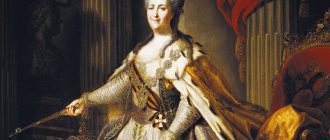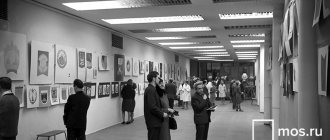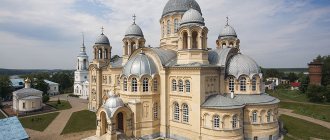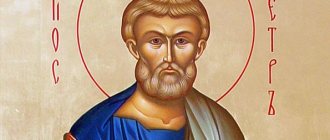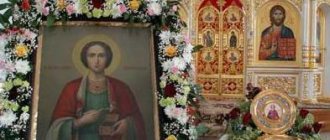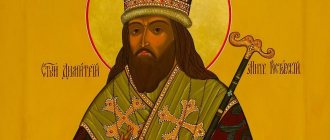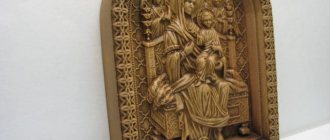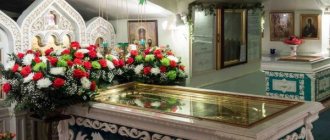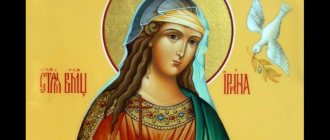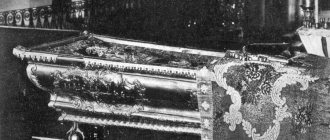"Save me, God!".
Thank you for visiting our website, before you start studying the information, please subscribe to our Orthodox community on Instagram, Lord, Save and Preserve † - https://www.instagram.com/spasi.gospodi/. The community has more than 60,000 subscribers. There are many of us like-minded people and we are growing quickly, we post prayers, sayings of saints, prayer requests, and timely post useful information about holidays and Orthodox events... Subscribe. Guardian Angel to you!
The image of the Great Martyr is considered one of the most revered shrines in the Orthodox Shrine, and it also personifies the intercessor for believers whose life has anything to do with military affairs, but he can also protect landowners. The divine face can be found on some city flags and even on coins.
The shrine of the Great Martyr can be addressed in a prayer service to all Orthodox Christians who have connected their lives with the defense of their homeland. They are called to the Saint to petition for intercession in military conflicts, and parents whose sons have been called to service also pray before the face, so that the image will protect them from all difficulties, and the service will go well.
In this article you can find out how the shrine helps and what the significance of the shrine is, what they pray for to the icon of St. George the Victorious, the day of celebration, prayers to the image and more.
- Prayer for help in work
How does the icon of St. George the Victorious help and its meaning?
This Saint is known to many Orthodox people, but not very religious people have also heard about him. However, not everyone knows what they can ask from the divine face, but this image is capable of healing anyone who sincerely asks.
The meaning of the icon of St. George the Victorious
The shrine, where a warrior kills a snake on horseback, personifies the extraordinary nobility and greatness of the displayed military courage. He is even depicted on some coats of arms and coins, and in Georgia this face is one of the first to be honored after the Queen of Heaven.
The Great Martyr George the Victorious is considered a saint thanks to his sufferings, which he endured because of his Orthodox faith, so strong that he could not exchange it for wealth or power. Faith is what is truly powerful and the most important thing that can be in a person’s life.
The best article for you, go to: St. Philip, Metropolitan of Moscow: life, icon, temple
All of the above exactly corresponds to the image of the Saint. According to stories that have survived to this day, while still in prison, he could help everyone who turned to him with a request. He cried out to God in prayer and he listened to him and fulfilled his requests, granting healing and help to those in need.
One of the greatest miracles that the Great Martyr performed was the salvation of the entire city from the terrifying serpent. Through prayers and his unyielding faith in the Almighty, he was able to defeat the monster. The saint killed the serpent, saved the inhabitants and their souls from the influence of the devil, giving them hope and faith in the Lord, calling people to accept the Christian faith.
Description of the holy image
To fully understand the meaning of the iconographic composition, one should turn to the life of the passion-bearer. George the Victorious was born at the end of the 3rd century and was a native of the Palestinian city of Lydda (present-day Lod, Israel). His father professed the teachings of Christ, for which he was brutally executed, and his pregnant mother fled to Palestine. There she gave birth to a son, whom she later gave a good education.
Icon of St. George the Victorious
The boy grew up strong and strong, and also had a sharp mind. All these qualities served him as a pass to the imperial army, where the future saint served in military service for several years. When persecution of Christians began under the leadership of Diocletian, George tried to convince the emperor to convert the ruler to Christianity. However, being an ardent pagan, he remained adamant, and instead advised the warrior to reconsider his views on life. When the soldier refused, the cruel tyrant ordered him to be tortured until he renounced Christ. But even during terrible torment, the passion-bearer did not betray the Lord. The sophisticated torture lasted a week, and after that St. George the Victorious was executed by beheading.
For his strong faith, perseverance and devotion to God, the great martyr was elevated to sainthood. Since then, he has been depicted as a rider on a snow-white horse, slaying a creeping reptile with a sharp spear. This is the most common image, symbolizing victory over evil. There are also icons where the monk holds a cross or sits on a throne. His face can be found on the flag of Moscow, since St. George the Victorious is the patron saint of the Russian capital.
Unfortunately, the location of the original miraculous image is still unknown. The last mention of it dates back to 1649. According to the ancient manuscript, the holy face belonged to the Vladyka Convent. Its dimensions were 75x75 cm, the frame was decorated with gold and silver, and also inlaid with precious stones. A candlestick was attached to the bottom of the robe. Legends say that the candle standing in front of the icon of the passion-bearer spontaneously lit on the eve of the raid of the Mongol-Tatar yoke.
Although the original was lost, several copies have survived. The most famous one is kept in the Vladychny Monastery and streams myrrh from time to time. The remaining lists belong to:
- Church of the Great Martyr George the Victorious in Starye Luchniki;
- St. George's Cathedral of the Odintsovo deanery;
- Church of St. George in the village. Monino;
- a temple erected in the name of the passion-bearer in the Moscow region.
Icon. Perv. half of the 14th century Byzantine Museum, Athens
St. George of the shoulder. Con. XII - early XIII century. Monastery of St. Catherine on Mount Sinai
Icon. 1130-1140 Moscow
The miraculous icon is honored several times a year:
- the 6th of May;
- November 16 and 23;
- 9th December.
How does the icon of St. George the Victorious help?
- Since ancient times, the Saint has been the patron saint of all military personnel and those who find themselves in the combat zone;
- They also very often turn to the shrine in the hope of protecting themselves from enemies and finding peace not only for themselves, but also for their loved ones. In order to receive assistance from the miraculous face, you need to place a candle next to its image and say your wish;
- In addition to all of the above, the icon of St. George the Victorious can also protect against various diseases. A large number of Orthodox Christians visit churches and cathedrals to call upon the saint in a prayer service for help in the fight against illness. There is also some evidence that this divine image can also cure female infertility;
- A prayer for victory also ascends to the divine face;
- The image also includes both men and women, and even children, since the Saint is able to help absolutely everyone who has even the slightest faith that his request will be fulfilled.
Some facts from the biography of the defender of the Russian land
Saint George is a symbol of a warrior who protects the earth. In Rus' he became one of the most revered saints after the Great Epiphany. Renunciation of wealth, sacrificing one's own life in the name of Christ - actions that helped Russian soldiers believe and pray to the patron.
St. George began to be depicted on coats of arms, flags, and icons. The face of St. George the Victorious has become an obligatory symbol of heraldry. Icons with the face of St. George were taken out before the start of battles that were necessary to protect the borders of the Motherland. Over time, temples were erected and squares were built in honor of St. Great George.
Childhood and youth
Historians note that the authenticity of George's life remains in question. Neither his real name nor his exact date of birth has survived to this day. They learn about the life of Saint George from Greek legends, Latin and apocryphal texts, and Islamic legends. According to most sources, George was born in the territory of modern Palestine, in Lida. His nationality is attributed to Cappadocia, modern Turkey, as his family settled there shortly after his birth.
Father - Gerundius, was a military man, mother - Polyhenia, owned several rich estates. George's parents raised him with clear ideas about Christianity, despite the fact that it was not easy. The third century was a time of flourishing paganism, so Christian teaching was not considered popular.
George was born between 275 and 281, and his birthplace was under the control of the Roman Empire.
Military service
Young people of that time dreamed of becoming soldiers and serving the emperor. When George turned 20, he also entered military service and gradually rose to the rank of colonel in the imperial army. A few years later his mother died, George became the heir to a large fortune. The service proceeded smoothly; for his courage and ability to achieve assigned tasks, the warrior was noticed by the emperor himself and brought closer to his court. George became the head of Diocletian's personal bodyguards.
Arrest
The year 303 was marked by the beginning of the persecution of Christians. The emperor demanded renunciation of Christ, complete worship of pagan gods, repentance and obedience. Close soldiers took part in the arrests of believers, carried out interrogations, torture, and executions. The reason for the arrest of Colonel Georgy was his behavior at one of the court hearings. He supported the Christians, then renounced his own wealth and distributed it to the poor.
Diocletian ordered George to renounce dissent. He asked him the question: “What is truth?” St. George replied that “Jesus Christ himself is the truth.” Diocletian ordered the warrior to be thrown into prison and tortured.
Torture and wheeling
According to apocryphal texts, the Saint’s torture lasted 7 days. They were sophisticated and cruel. Many ancient testimonies tell us that it was torture that marked the beginning of the further elevation of George to the rank of holy great martyrs.
- First day. During the arrest, George was pushed into prison with long military spears, but one of them broke in half, like a light twig.
- Second day. George was tied hand and foot, and a heavy granite stone was placed on his chest. The martyr's bones crunched, but he continued to pray.
- The third day. George was tied to a wheel, which was studded with sharp blades and nails. While the wheel was spinning, George prayed. When he lost consciousness, the emperor ordered him to be thrown to the bottom of the pit for further burial. In the morning it turned out that Georgy was still alive.
- Fourth day. George was thrown to the bottom of a stone well and covered with quicklime on top. George experienced inhuman torment, but remained alive.
- Fifth day. George was shackled and iron boots heated over coals were put on his feet.
- Sixth day. Georgy's arms and legs were beaten with sledgehammers until his bones were broken.
- Seventh day. Throughout the day, the soldiers tortured George with whips made from buffalo sinews.
After the torture, he was left alone for some time. At the bottom of the stone prison he prayed and preached the life of Christ. Diocletian decided to execute him.
Execution
The Emperor personally appeared to George and repeated his request to renounce Christ and return to paganism. The warrior asked permission to visit the temple of Apollo. This was regarded as possible consent. There, in front of the statue of Apollo, George made the sign of the cross and asked Apollo: “If you are God, do you want to accept my sacrifice?”
According to numerous legends, the statue was possessed by an evil spirit who called himself a fallen angel. A conversation with the future saint provoked the fall of pagan statues in the temple, which became the basis for the further collapse of all paganism. Diocletian pacified the crowd with the bloody, cruel execution of George. Along with him, the wife of the emperor himself, Empress Alexandra, was executed. She took the side of the Christian martyr and asked her husband to publicly pardon him, but the emperor was inexorable and ordered both of their heads to be cut off.
A miracle created by a divine image
The saint became famous for his many miracles, but the most famous of them was the miracle of the serpent:
According to a legend, not far from the town of Beirut, a snake lived in a lake; local residents were in constant fear, because the monster was devouring people.
Some superstitious residents, in order to quench the serpent’s rage, constantly, according to the lot that fell, gave a young girl or boy to be devoured by the monster.
The best article for you, go to: Icon of Gordius of Cappadocia
According to legend, once the lot pointed to the king’s daughter, she was sent to be torn to pieces by the serpent, and then the divine appearance of the Wonderworker took place. The saint saved the princess by piercing the monster with a spear, and also stopped pagan rituals and called on the residents to accept the Christian faith.
Meaning and history of origin
St. George the Victorious is called a witness of faith. The main texts from which his biographies were compiled:
- Viennese palimpsest (5th century);
- life of Metaphrastus (10th century);
- laudatory word of Andrew of Crete (8th century).
They testify to the cult of St. George that emerged in the 4th century, which gave rise to many popular legends. Veneration in Arab countries is associated with legends, tales, stories about posthumous miracles associated with the name of the holy great martyr.
Europeans praise St. George the Victorious as the patron saint of warriors. The Orthodox Church honors the memory of the Great Martyr George under the name Yuri or Yegor; according to the Orthodox beliefs of the peasants, St. George patronizes not only soldiers, but farmers and cattle breeders.
When is the day of veneration of St. George celebrated?
In Christian churches, celebrations in honor of the Reverend are celebrated several times a year:
- December 9 (according to the old style, November 26) - the Russian Christian Church, at the behest of Prince Yaroslav the Wise (baptismal name George), began to celebrate as a memory of the consecration of the Kyiv Cathedral by the Great Martyr on this day;
- November 23 (November 10, old style) - this day Georgia celebrates the venerable wheeling;
- November 16 (old style November 2) - a memory of the cathedral in Lydda, renovated in the 4th century, named after the Saint;
- May 6 (old style April 23).
Lifetime miracles
In addition to posthumous miracles, lifetime miracles associated with the days of George’s torture are known. The faith of Saint George was so great that God helped him resurrect a dead Christian. After this, people began to come to the dungeon where George was sitting. There they said prayers, asking for help in illnesses and troubles.
Among posthumous miracles, the most popular legend is the legend of St. George the Victorious as a snake fighter. The legend says that he defeated the insidious serpent who enslaved the city of Lebanon and ruined the country. According to legend, the pagans, in order to appease the serpent, supplied him with human victims.
When the choice fell on the royal daughter, the Majestic Horseman appeared on a white horse with a spear in his hands. Having made the sign of the cross and appealed to Christ, he rushed at the serpent and struck it with a spear. After the announcement of this event, the population of the city accepted the faith of Christ.
The Victorious One, who pierces a serpent with a sharp spear, means for the Russians a symbol of victory over the horde. This image was firmly established in the heraldry of the Moscow state and became the basis for the creation of the Byzantine double-headed eagle, which was an ancient symbol of the royal seals and coats of arms.
Saint George the Victorious, as a warrior, was revered on the territory of Georgia. Residents of Ossetia depict George as a gray-bearded old man in armor, who, according to legend, won many victories, appearing to soldiers during battles or before them.
Information! Many legends tell that St. George the Victorious defeats not the serpent, but the dragon.
Prayers addressed to the miraculous image
Prayer for help in work
“Saint George, Victorious and Savior. Come down to me from heaven, give me strength in work, endow me with your spirit in tireless struggle. Help me overcome the litigation that happens at work, don’t let the bosses swear. If I am destined to be cut short, I want to be forgiven by Christ. Thy will be done. Amen".
Petition for victory in sports
“Oh, all-praised holy great martyr and wonderworker George! Look upon us with your quick help and beg God, the lover of mankind, not to judge us sinners according to our iniquities, but to deal with us according to His great mercy. Do not despise our prayer, but ask us from Christ our God for a quiet and godly life, mental and physical health, fertility of the earth and abundance in everything, and may we not turn the good things given to us by you from the all-generous God into evil, but into the glory of the holy name Him and in glorification of your strong intercession, may He grant our Orthodox people victory as adversaries and may He strengthen us with irreplaceable peace and blessing. May His angel protect us saints more generously with a militia, so that we, upon our departure from this life, may be delivered from the wiles of the evil one and his difficult airy ordeals, and may present ourselves uncondemned to the throne of the Lord of glory.
Hear us, passion-bearing George of Christ, and pray for us unceasingly to the Trinitarian Lord of all God, so that by His grace and love for mankind, with your help and intercession, we may find mercy with the Angels and Archangels and all the saints at the right hand of the just Judge, and we may glorify him with the Father and Holy Spirit, now and ever and unto ages of ages. Amen".
Prayer for protection
“Holy, glorious and all-praised Great Martyr George! Gathered in your temple and before your holy icon, people worshiping, we pray to you, known to the desires of our intercessor, pray with us and for us, beseeching God from His mercy, may he mercifully hear us asking for His goodness, and not abandon all ours to salvation and life needful petitions, and grants our country victory in the face of resistance; and again, falling down, we pray to you, victorious saint: strengthen the Orthodox army in battle with the grace given to you, destroy the forces of the rising enemies, so that they will be ashamed and put to shame, and let their insolence be crushed, and let them know that we have Divine help, and to everyone in sorrow and the current situation, show your powerful intercession. Pray to the Lord God, the Creator of all creation, to deliver us from eternal torment, so that we glorify the Father, and the Son, and the Holy Spirit, and we confess your intercession now, and ever, and unto the ages of ages. Amen".
God bless you!
The best article for you, go to: How does the Icon of Mary Magdalene help?
How to ask a saint for help correctly
In church it is easier to tune in to prayers and free yourself from extraneous thoughts. Arriving at church, one should repent at the icon of the Savior and ask for forgiveness of sins. Then they light a candle near the icon of St. George the Victorious and read a prayer asking for help.
Important: at the end, be sure to thank the Lord and the saint for listening to us and not leaving us without help.
If it is impossible to visit the temple, they pray in front of the home icon of the Victorious:
- It is better to read the prayer in an empty room, turning off gadgets and TV.
- A candle is lit in front of the image.
- They tune in to prayer, banishing all thoughts from their heads, turning all spiritual aspirations to the Lord and the saint.
- They read the prayer standing, out loud or mentally. They make the sign of the cross and bow. If available, drink consecrated water.
- Concluding the prayer, thank you for your help.
Prayers to St. George help people in good deeds. You should not expect instant help, nor should you hope for support for those who do not believe in the Lord or have decided to turn to the saint for the sake of unrighteous actions. St. George the Victorious protects and saves if one deeply and sincerely prays for victory over the enemy, intercession in the face of dangers, in difficult life situations.
How to position the icon correctly
To begin the prayer, the icons are placed in front of one’s face or the ritual is performed by kneeling in front of the place where they are kept permanently. There are several rules for the location of the home iconostasis:
- The icons are placed on the eastern walls of the house. They should be located where one can kneel before them for prayer.
- Images of saints can stand on a shelf or hang on the wall. Lamps or candles are placed in front of them.
- When arranging several icons, it is important to respect the principle of hierarchy.
- Beautiful napkins are spread under the icons, which in church rituals are called shrouds.
- Lamps are lit during prayers, on Sundays and holidays.
- Holy water, which is brought from the temple, is kept next to the icons.
Warning! It is prohibited to place icons next to clocks, panels or photographs. This is inappropriate .
Where is the shrine located?
According to the apocrypha and Greek legends, the relics of St. George were buried in Israel, in the modern city of Lod. Lod is a town located south of Tel Aviv. This city was in the past the city of Lydda, and also bore the name Georgiopolis, Diospolis.
Lod is mentioned many times in the New Testament scriptures. It is known that after one of the Jewish wars the city was completely destroyed by the Romans, as a center of disobedience of the Jewish population. Later, a colony was formed on this site, which was called the “city of the gods.” The city was named Georgiopolis in honor of St. George the Victorious, and bore this name for several centuries.
The main attraction of Lod is the tomb of St. George the Victorious, owned by the Orthodox Church of Jerusalem. The tomb was erected in the 5th century, much later a temple was built around it, called St. George. During the wars of independence, the church was destroyed several times, but was constantly restored. Date of last restoration: 1870.
The warrior's weapon and its head are kept above the main altar of the Roman Temple of San Giorgio - en Vila bro, which is dedicated to the saint. San Giorgio is built in basilica style. The relics have been there since the beginning of the 12th century. They were brought here at the behest of the Pope, Gregory IV.
Some of the relics are housed in the Holy Chapel in Paris. This is a Gothic building with the status of a reliquary. Valuable relics are adjacent to a crown of thorns, stained with Christ’s blood, particles of the Holy Cross, as well as part of a Roman soldier’s spear, which was thrust under the ribs of Christ hanging on the cross.
The right hand (or right arm up to the elbow) is preserved on Holy Mount Athos, located in the south of Greece in the Xenophon monastery. The cathedral church of the monastery was built in honor of St. George the Victorious, among the famous shrines: parts of the relics of Marina the Great Martyr, Jacob the Persian, Martyr Paraskeva.
Information! Yuri Luzhkov accepted part of the relics of the Great Martyr George as a gift from the Patriarch of Jerusalem. Since 1998, they have been kept in a small temple built on Poklonnaya Hill.
Iconography
In iconic drawings and frescoes, George appears as a brave warrior or martyr glorifying the faith:
- Dressed in a tunic, raising a spear and sitting on a white horse, George pierces a dragon or serpent, thereby symbolizing superiority in battles with enemies. Next to the monster, on some icons there is an image of the ruler’s daughter, who was saved by a warrior. This is a symbol of protecting the people from the enemy, getting rid of the threat of battles.
- With a red cloak on his left shoulder, George appears as a great martyr. The saint holds a spear, as a memory of the status of the Victorious, and a cross, as a symbol of endless faith and worship of Christ.
- St. George the Victorious, sitting on the heavenly throne, receives a martyr's crown from an angel. This is the oldest image telling of the warrior’s acceptance of the face of the great martyr.
- The iconographic arch depicts the Victorious with other holy wars, for example, the image of St. George and Demetrius of Thessalonica on horseback is known.
Numerous frescoes in temples and churches depict George as a winner or martyr. One of the famous frescoes depicts him as a Christian bringing the word of God to people. He walks the earth wearing a scarlet martyr's cloak with an angelic halo around his head. The Novgorod icon, painted using the easel painting technique, stands apart. On it, George is drawn up to the waist. The icon is one of the most ancient.

